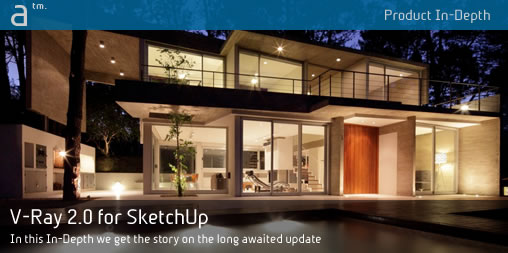Continued from page 1
Speed, Simplicity and Power
With each release the company says V-Ray is getting easier and easier to learn. “We are putting a lot of attention in this area,” said Corey Rubadue, product director for Chaos Group in the US. “This really hits home with the SketchUp product because–as I am sure you know–SketchUp has the fewest buttons and parameters of any modeler out there used by professionals that I know of.”
Advertisement
This directive towards simplicity for V-Ray for SketchUp has made version 2.0 special and is changing the face of V-Ray. “We have made sure that the V-Ray controls feel and work as closely as possible to the host application,” says Corey Rubadue, “this really strikes a chord with the SketchUp product and audience.”
Dome Light
V-Ray 2.0 for Sketch has three major new features. The first of these is the new Dome Light. The new Dome Light simplifies the setup of image-based lighting (IBL). HDR images are “high dynamic range” background images that are utilized as a source for lighting a scene as well as its environmental background.
With the new Dome light “if there is a sun in the image V-Ray will now treat it like a sun light source,” says Rubadue. V-Ray accomplishes this by analyzing the the exterior HDR image and finding its brightest spot. This spot is recognized as a sun light.
What happens to the SketchUp sun and sky?
That’s a good question. V-Ray 2.0 for SketchUp fully coordinates and integrates itself with the SketchUp sun and sky and interprets it into its more advanced V-Ray sun and sky system.
V-Ray RT: The Power of CPU/GPU Rendering
The second most key feature in V-Ray 2.0 for SketchUp is the new V-Ray RT (for real-time) rendering system. This is an alternate high-performance, interactive rendering engine. At the time of our conference call with the Chaos Group the RT version was only utilizing the CPU but they somehow managed to execute the GPU side as well–a testament to the performance of its programmers back in Bulgaria.

02 – V-Ray RT is a new interactive renderer in the SketchUp product. Interactive rendering is key for companies like global architectural leader Gensler. Rapid design decision making is sped up dramatically with V-Ray RT. (image courtesy Chaos Group and Gensler; Copyright Gensler. All rights reserved).
“V-Ray RT is very important to many of our customers, like Gensler,” says Lon Grohs. “Gensler is one of our biggest customers and for a firm like them it is critical to get immediate feedback on their design options for decision making. And they can do this directly from the render frame buffer.” (see image 02 above and 05 on the next page)
V-Ray RT is built directly on the core V-Ray software core, said the company, making it completely scene, material and lighting compatible regardless of what rendering engine you decide to use. Using RT is as simple as hitting the RT button in the V-Ray interface in SketchUp.
V-Ray Proxy
V-Ray Proxies are a new feature and a valuable one for SketchUp users in particular. V-Ray proxies are a type of V-Ray mesh file that is saved to your hard drive and dynamically loaded at render time, as needed, during the scene and animation renders. This enables users to throw models with millions of polygons at SketchUp and not have the popular 32-bit application come crawling to its knees. (see image 03 below)
“Proxies become very important to managing memory of your scene,” says Corey Rubadue, “especially in a 32-bit application where there are real limits on your application’s memory.”

03 – The extensive trees in this SketchUp scene are utilizing V-Ray Proxy technology. A much more detailed version of the tree with thousands of faces gets reduced through the Proxy setup with the end user controlling the amount of faces left to represent the trees. SketchUp remains responsive because the geometry in the OpenGL viewport is both reduced and yet V-Ray dynamically loads the millions of faces in the final scene during render time–even with RT renders.
Corey explains further, “The proxy is a so called ‘dynamic geometry’ which means V-Ray is going to read from the file what it needs at render time.” All the trees, foliage and the grass shown in the next page (and the title graphic) contain millions of polys. Yet the SketchUp model in our presentation by the Chaos Group moved around as if it just contained the house geometry. This was impressive, especially if you have pushed SketchUp to its limits. (see image 04 for the proxy setup palette).
next page: Other Improvements in V-Ray 2.0 for SketchUp







Reader Comments
Peeradon Warithkorasuth liked this on Facebook.
Peeradon Warithkorasuth liked this on Facebook.
Thomas Bank liked this on Facebook.
Thomas Bank liked this on Facebook.
[…] 2.0 for SketchUp 2.0 was featured here on Architosh for those who want to learn about accessing this […]
Comments are closed.